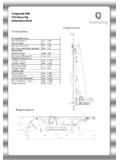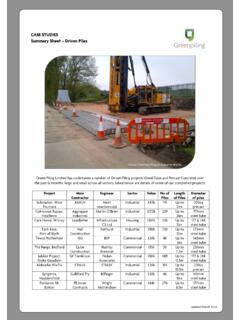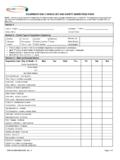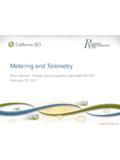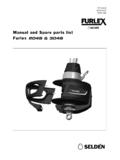Transcription of Maint procedures May 2011 - Green Piling
1 MAINTENANCE procedures Issue Date Revision By Latest Review Amendment Page 1 May 2011 4 RP May 2012 Re written and extended Maintenance procedures MAINTENANCE procedures Issue Date Revision By Latest Review Amendment Page 2 May 2011 4 RP May 2012Re written and extended Introduction: The provision of safe plant and work equipment and its maintenance in a safe condition is stated within the company health and safety policy and is regarded as essential to control risks from dangerous parts of machinery and plant notably ( Piling rigs). The aim of these procedures is to introduce and maintain formal systems for maintenance and servicing of Piling rigs and associated ancillary equipment. The quality of maintenance is a major contributory factor affecting safety and operational costs. It affects the operating life of plant and also the risk of accidents during or following maintenance.
2 The possibility of a fatal accident is present in many maintenance activities and includes the company s maintenance work. Safety during maintenance is heavily reliant on human activity and accordingly management will take positive steps to ensure maintenance staff are sufficiently trained and competent to carry out their work safely. This manual contains the procedures and instructions for general machine safety and maintenance work. Objectives: The aim of these procedures is: To meet statutory duties provide and maintain safe work equipment To enable the company to demonstrate that a programme of routine maintenance of plant and machinery is in place and being followed To clarify with personnel the formal arrangements for machine safety and their duties for compliance. Scope The machinery safety procedures apply to all types of work equipment and all areas where plant and work equipment is used.
3 Contents and Related Documents 1. Machine safety policy recognising statutory requirements and allocation of responsibilities to implement the policy. 2. Maintenance Responsibilities MAINTENANCE procedures Issue Date Revision By Latest Review Amendment Page 3 May 2011 4 RP May 2012Re written and extended Green Piling Plant 3. Operator plant report sheet page 10 4. Operator daily inspection checklist Driven page 11 CFA page 13 Forklift page 15 5. Operator weekly inspection checklist Driven page 12 CFA page 14 Forklift page 16 6. Fitters service report sheet page 17 Third Party Plant * 7. Access Platform page 18 8. Concrete Pump page 19 9. Concrete Drum page 20 Third party plant is plant usually hired in from plant supply companies. Routine daily pre use and in use inspections are required to be carried out by Green Piling Operatives but more and other maintenance and repairs will normally be carried out by hire company.
4 Sheets used for control herein are not necessarily an exhaustive list but all requirements should be detailed in instructions with plant ant during familiarisation at delivery. MAINTENANCE procedures Issue Date Revision By Latest Review Amendment Page 4 May 2011 4 RP May 2012Re written and extended Objective To provide a system that will ensure that the company does not put personnel at risk during operations involving the use of work equipment. To meet statutory duties and, or, industry standards to provide and maintain safe work equipment. Responsibility Responsibility for communication and compliance with this policy rests with the Directors of the company. The Directors shall nominate a responsible person to manage implementation of this policy. Preparation of the machine safety policy is the responsibility of the Safety Advisor. Responsibility for ensuring the machine safety policy is administered on site rests with the Contracts Manager, Rig Foreman and the Maintenance Engineer.
5 Each responsible person nominated shall be given sufficient time, resource, training and information to carry out their responsibilities effectively. The Provision and Use of Work Equipment Regulations 1998 (PUWER 98) make more explicit the general duties contained in the HSW Act. The Regulations apply to all work equipment, including second hand, hired or leased equipment. The provisions of the Supply of Machinery (Safety) Regulations 1992, as amended, apply to machinery manufactured on or after 1 January 1993. Note (PUWER) (LOLER) and industry standards are applicable to Piling Rigs. Interpretation The following definitions and terms are important in understanding the requirements laid down by (PUWER98) Regulations. Inspection This means a visual or more rigorous inspection, as required by regulation 6 carried out by a competent person, and may include appropriate testing.
6 Work equipment This includes all plant, machinery, tools or installations for use at work the definition will cover large machines such as Piling rigs right through to complete entities such as ladders, hydraulic jacks, air tools, spanners etc. Use MAINTENANCE procedures Issue Date Revision By Latest Review Amendment Page 5 May 2011 4 RP May 2012Re written and extended This includes any activity that may be associated with the work equipment, such as starting, stopping, programming, setting, transporting, repairing, modifying, maintaining, servicing and cleaning. Unless otherwise stated the requirements of these Regulations are absolute, ie they must be achieve. Application The Regulations apply to: work equipment provided by employers for use by their employees at work work equipment provided by self employed persons for their own use at work persons who have control of work equipment, or who use, supervise or manage it.
7 The way work equipment is used. The guidance points out that the duty on employers also extends to personal work equipment provided by the employees, where the employer agrees to this practice and that on multi occupancy sites arrangements should be made for one employer to be responsible for compliance. The "co operation and co ordination" requirement under regulation 11 of the Management of Health and Safety at Work Regulations 1999 (MHSW) is relevant. The Company shall ensure the following: Suitability Equipment provided for work is constructed or adapted so as to be suitable for its intended purpose. This includes taking account of reasonably foreseeable working conditions, inherent health and safety risks where the equipment is to be used and any risks associated with the equipment itself. Work equipment must only be used for tasks, and under the conditions, for which it is suitable.
8 "Suitable" in this regulation means suitable with respect to the health and safety of any person. Regulation 3(1) of MHSW, ie risk assessment, is relevant. Maintenance Work equipment is maintained in an efficient state, in efficient working order, in good repair, and where a maintenance log is required, ie under other legislation (eg CHSWR96) or (LOLER) such logs must be kept up to date. However, the accompanying guidance does recommend that maintenance records are kept. Inspection Where the safety of work equipment depends on the installation conditions, the work equipment is inspected after installation and before it is used for the first time, or after it has been installed at a new location or premises. The inspections are to ensure that the work equipment has been installed correctly and is safe to use. In addition, work equipment which is exposed to conditions which may cause deterioration and consequent danger as a result of that deterioration must be inspected at suitable intervals, and whenever exceptional circumstances have occurred that may have had adverse effects on the safety of the work equipment.
9 The inspections are to ensure that health and safety conditions are maintained, and that defects are identified and corrected quickly. Records of all inspections must be made and kept until the next inspection has been completed and recorded. No work equipment may leave an employer's undertaking, or be used in the undertaking, if supplied by another person, unless there is accompanying physical evidence that the last inspection was carried out. Note; Construction (Health, Safety and Welfare) Regulations 1996 have specific inspection requirements. MAINTENANCE procedures Issue Date Revision By Latest Review Amendment Page 6 May 2011 4 RP May 2012Re written and extended Specific Risks Ensure that where the work equipment poses a specific risk to health and safety, the use and maintenance of such equipment will be restricted to designated persons who have received adequate training in the operations they have been designated to carry out.
10 Information and Instructions; Training Make available to all persons using work equipment adequate health and safety information, and where appropriate written instructions on the use of such equipment. In addition shall also provide adequate health and safety training in the use of the work equipment, including any associated risks and necessary precautions with specific attention given to young or inexperienced persons. Conformity with EC Requirements Take reasonable action to ensure that work equipment provided for use after 31 December 1992 has been designed and constructed in compliance with any essential requirements that are contained in any relevant UK legislation which implements appropriate EC "product" Directives. Dangerous Parts of Machinery Take reasonable measures to prevent access to dangerous parts of machinery or stop the movement of any dangerous machinery before any part of a person enters a danger zone.


